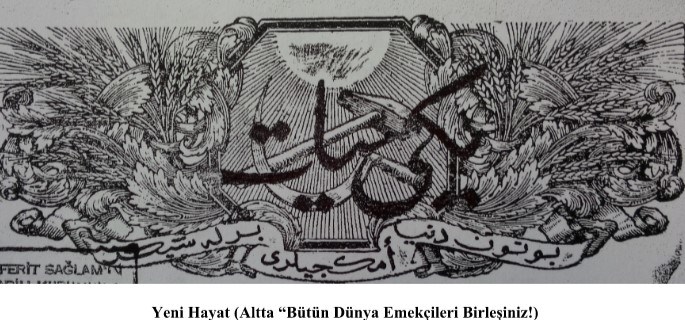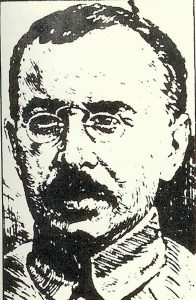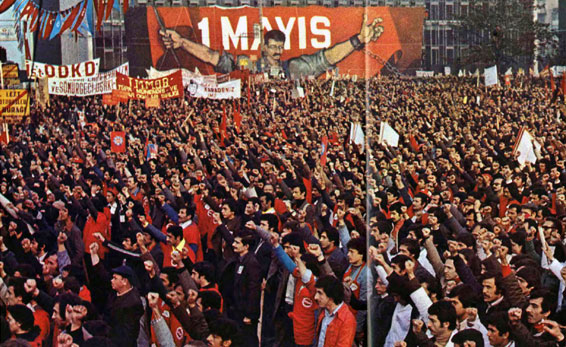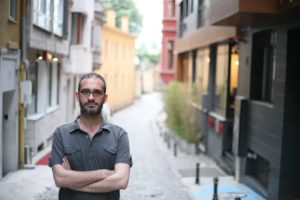
We have interviewed prolific Turkish leftist commentator Foti Benlisoy on the history of the Turkish left, from its Ottoman beginnings on to the present day. In what follows, Benlisoy provides a historically grounded perspective on the background and prospects of today’s movements to counter the now regnant authoritarian conservatism. He also outlines the left’s recurrent tensions between advocacy for national and religious minorities and the defense of a unitary, sovereign Turkish nation-state.
In an upcoming second part, Benlisoy will examine the situation since the 1980 military coup, attending particularly to the shifting social basis of the organizational left, in the vicissitudes of the traditional proletariat and of a managerial middle class caught between social patriotism and the seductions of neoliberalism. Please stay tuned!
LE: One of the goals of the LeftEast summer school in Istanbul (July 15-20, 2016) was to foster connections between the Turkish and East European left. At the same time, the events that took place during those days (an attempted coup by sections of the army followed immediately by a counter-coup of the Erdoğan regime) not only prevented most Turkish participants from showing up but also made it abundantly clear to us why our lefts are so different. So let me take advantage of your knowledge about the international history of the Turkish left, and ask you about its connections with the East European left, starting from the very (Ottoman) beginning.
FB: The Ottoman left was to a great extent an offspring of Balkan-East European socialism. First, you have the Armenian revolutionary national organizations, which were affected strongly by the Russian populist movement. During the first decade of the 20th century these organizations (The Armenian Revolutionary Federation and Hintzak) had become socially rooted in Ottoman Armenia and had popularized socialist-populist themes. The Armenian Revolutionary Federation (Tashnak) had become a member of the Second International in 1907. On the other edge of the empire, you have two different brands of Balkan socialism. On the one hand, there is the famous Socialist Workers Federation of Salonica [Thessaloniki],which was defending a position regarding the national question that was akin to Austrian Marxism and the Bund in Russia. Although it was an organization that represented mainly Jewish workers, it sought to appeal to Greek, Bulgarian and Muslim workers as well. The Salonica Federation asserted that all nationalities in the empire should have their own socialist organizations and that these should be organized under a federation. Such an understanding regarding the autonomous organization of the nationalities was the key to preserving the Ottoman Empire. The Socialist Federation of Salonica was also linked to the Second International. On the other hand, you had Bulgarian social democracy (especially the “narrow”-tesni-faction of it) which played an immense role in shaping the first socialist organizations and trade unions in Istanbul. With the support of some international leaders of social democracy like Parvus and Rakovsky, figures like Vasil Glavinov and Theodor Sivachev helped introduce into the Ottoman Empire what Lars Lih calls “Erfurtianism,” that is, the basic tenets of European (German) social democracy. One should not forget also the impact of the left-wing of the Interior Macedonian Revolutionary Organization (IMRO). One member of this organization was Dimitar Vlahov, who was elected in 1908 as deputy from Salonica and consistently raised in the Ottoman Parliament the issue of workers’ rights.
However, these early organizational and programmatic links with Eastern European and Balkan socialism proved short-lived. As is well known, the transition from the Ottoman Empire to the Turkish Republic was characterized by ethnic cleansing and genocide. The nationalist conflicts of the years 1912-1922 eliminated the first multi-ethnic socialist attempts and this rupture led to the formation of socialist movements that were purely national (Greek, Turkish etc.). Thereafter, the links between the Turkish left and East European left become limited to the confines of rather bureaucratic relations within the context of the Moscow-oriented international Communist movement. For example, during the Cold War, the Turkish Communist Party had an “external bureau” based in Eastern Europe, with broadcasting facilities. Bu one has to admit that these links have nothing to do with the vibrancy of the programmatic and organizational intercourse of the late Ottoman years.
At the 1920 Baku Congress of the Peoples of the East, the Comintern’s major early initiative vis-à-vis the non-Western world, the Turkish delegation was probably the largest outside of the former Russian empire and a Communist Party of Turkey was founded the same year, only to be shortly clamped down on by the Kemalist government. And yet for the next couple of decades the USSR maintained friendly relations with the Turkish Republic. Didn’t Turkish communists feel betrayed by Soviet/Comintern support for a government by the national bourgeoisie that was actively suppressing them?
The Turkish left that emerged after the end of the First World War had three roots. The first came from the Ottoman prisoners of war in Russia who had adopted Bolshevism. This group, led by Mustafa Suphi, formed the Communist Party of Turkey under the auspices of the Soviet Republic and the Third International. A second group was formed by the students who came from Germany, influenced by the revolutionary turmoil there—that’s why they were called Turkish Spartakists—and by other political exiles like Şefik Hüsnü. These formed the Türkiye İşçi ve Çiftçi Sosyalist Fırkası in Istanbul, while some members of the group later joined the national struggle in Ankara. It is important to note that during the post-WWI occupation by British, French, and Italian forces, Istanbul witnessed a vigorous workers’ movement that enabled the formation of various socialist groups with some influence over the workers of the city. Lastly, the third group consisted of rather heterogeneous groups sympathizing with the Bolsheviks in the USSR and was scattered across Anatolia.
The major recruitment pool of these left currents came from former members of the Committee of Union and Progress. The intellectual disorientation and the existential crisis that followed the end of the war brought many former members of the CUP to revolutionary ideas and to Bolshevism. A significant part of the Unionist political, intellectual and military elite turned its eyes to the Bolsheviks as a source of inspiration in this moment of acute crisis. The new Soviet regime appeared as the sole hope for the salvation of the empire. In the words of Doğan Avcıoğlu, “to become Bolshevik instead of becoming Armenian” seemed the only option left to save Turkish independence. Thus, every component of the Turkish left in this period, that is, the Turkish Communist Party, the Green Army Society, the Populist Group in the National Assembly, the official Communist Party, the Halk İştirakiyun Fırkası (the People’s Communist Party) had become inundated by a mass of members of the CUP. Many intellectuals and activists who until the end of the war were ardent Turkish nationalists and even Pan-Turkists turned their faces toward Bolshevism.
What strikes the observer of the newly developed Turkish left currents of this period is the central role assigned to Islam. In Anatolia in many cases Bolshevism was treated simply as an extension of Islamic principles. To give an example, according to the deputy from Bursa, Şeyh Servet, who was also one of the founders of the People’s Communist Party of Turkey (Halk İştirakiyun Fırkası), Bolshevik principles resembled the Age of Felicity (Asr-ı Saadet), that is, the times when the Prophet lived. Increasingly the Bolshevik revolution was interpreted according to the West/East dichotomy and antagonism. Accordingly, Bolsheviks were seen as representatives of the East striking fatal blows to the West, as harbingers of the rise of Asia and the inevitable collapse of Europe.
But the rise of the left opposition threatening the leadership of Mustafa Kemal Pasha over the national movement would lead to his change of attitude against these currents. Moreover, relations with Bolsheviks and the newly emerging Communist left became part of the implicit antagonism between Mustafa Kemal and the exiled Unionist leaders over the leadership of the national struggle. The zenith of the strength of the left was the election by the National Assembly of Nazım Bey, the deputy from Tokat and a leading figure of the People’s Group (Halk Zümresi) in which leftists were very active, to the ministry of Interior instead of Refet Pasha, Mustafa Kemal’s favored candidate. Nazım Bey was forced to resign afterwards and Mustafa Kemal Pasha adopted a policy of crackdown towards leftist currents.

In order to contain and control the increasing influence of Bolsheviks and the left-leaning factions in the Grand National Assembly, Mustafa Kemal even took the rather bizarre step of establishing an “official” Communist Party of Turkey staffed by “rational and trustworthy friends” on 18 October 1920. This party aimed at the monopolization of pro-Communist policy. Such tactical manoeuvres were accompanied by political violence: in January 1921 Mustafa Suphi (the leader of the Comintern-recognized Communist Party) and his 15 comrades were murdered in Trabzon. Afterwards the legal People’s Communist Party of Turkey was closed and its deputies were arrested. The Green Army Society was dissolved. In spring 1921 the newly established Ministry of Religious Affairs issued a “fatwa” that denounced Bolshevism as a dangerous and false tendency and called the believers to resign from the People’s Communist Party of Turkey.
After the repressions beginning in 1921, the fate of the Turkish left increasingly became subject to the tides of Turkish-Soviet relations. In the Turkish-Soviet friendship and commercial treaty of 16 March 1921, the Ankara government agreed to repress all pan-Turanian agitation and in turn the Soviet government agreed not to promote anti-government agitation in Turkey.
The end of hostilities and the liberation of the country changed dramatically the tone of the relationship between the Kemalists and Moscow. The People’s Communist Party was finally dissolved and accused of espionage on behalf of the Soviet Union and many militants were arrested. But despite this new wave of repression, the Comintern did not press for the release of the prisoners and instead in its Fourth Congress stressed the importance of Turkish-Soviet friendship before the Lausanne Conference. The Second Congress of the Communist International had adopted after intense debate the position of supporting bourgeois nationalist anti-imperialist struggles. The Third Congress, which had met in 1921, issued a call to support the Kemalists and the national liberation movement. Following this line the Fourth Congress declared “its support to any national revolutionary movement against imperialism,” including Turkey’s, and reaffirmed the decisions of the Third Congress concerning the support of communists of the colonial or semi-colonial countries for the nationalist bourgeoisie. According to the Comintern, “in the colonial East at the present time the key slogan to advance was the anti-imperialist united front” and “the demand for a close alliance with the proletarian Soviet republic was the key-note of the anti-imperialist united front.”
Thus, the government of Ankara was reassured once more that it could repress its national Communist Party without endangering the support and goodwill of the Soviet government. Previous Soviet representatives like Şerif Manatof who actively tried to organize Communist groups in Anatolia were replaced by more “trustworthy” and “diplomatic” representatives like Semyon Aralov. The persecuted Turkish communists were even accused of “left adventurism” and thus discredited. Therefore, this whole process revealed that Turkish-Soviet relations were increasingly based primarily on a governmental basis. Being depended on the pendulum of Turkish-Soviet relations led the Turkish communist movement to become an isolated sect with unpredictable policies. Unable to perform mass work because of the continuous oppression and forced to remain underground, the movement remained small and ineffective.
The history of the Turkish left seems to me a history of discontinuities. During the 1960s-70s, another major moment for the Turkish left, it comprised a volatile cocktail of pro-Soviet, Maoist, Hoxhaist, Trotskyist groups, intellectual circles, urban and rural, Kurdish and Alevi guerillas. As you can imagine, to the East European ear, which associates this period of the left with struggles between “socialism with a human face” and neo-Stalinism, with the state balancing between the two, this all sounds very rich and exotic. So that we won’t get lost in an alphabet soup of organizational acronyms, could you tell us of the main debates and strategies within the Turkish left of that period? Outside of the official Turkish Communist Party, which presumably was still receiving instructions from Moscow, what if any was the relationship between sections of the Turkish left and Eastern European or Soviet left?
With the 1960s Turkey entered a twenty year period in which almost every form of social struggle was experienced by millions of people: from the youth movement to peasant mobilizations, from working class movements to urban guerrilla activities. One can easily say that these twenty years, until the military coup of 1980, constitute the heyday of the Turkish left. The 1960s are the formative years for the Turkish left in the sense that it was the first time that leftists participated and led mass struggles. During the early 1960s the Turkish Labour Party (TİP) was the main attempt for an independent, class-based leftist political party. The Party took 3% of the vote in the elections of 1965 and entered the parliament. However the ideological and political struggle within the leftist movement led to many splits in the Labour Party and to the formation in the 1970s of several organizations. One major rift was between pro-Russian and pro-Chinese organizations. However, during the 1970s the major organizations of the Turkish left (with the exception of the Turkish Communist Party) were ex-Guevarist and left-populist movements like Devrimci Yol (Revolutionary Path) and Kurtuluş (Liberation).
In fact, it was the second half of the 1970s that became the litmus test for the Turkish left. Since despite the level of social struggles at that time, the left was unable to put forward a coherent political programme and strategy, especially as an alternative to the Kemalist Republican People’s Party. You had slogans like “one solution—revolution” but no revolutionary strategy. Although you had a vibrant atmosphere of political and theoretical creativity in the 1960s, during the second half of the 1970’s a certain dogmatism prevailed. The ready-made formulas of the pro-Soviet, Maoist, Hoxhaist and Guevarist movements were seen to be enough to explain almost every theoretical and political problem. An older Comintern analysis regarding Kemalism as a progressive and anti-imperialist movement had also a rather permanent effect on the strategic orientation of many organizations. You had also defects of Stalinist origin—both theoretical (stageism) and organizational (monolithic, non-democratic organizations). Another problem was the political and organizational fragmentation and especially the sometimes violent internencine struggles between left-wing groupings. These (sometimes bloody) confrontations especially in the mass organisations like trade unions and student organizations etc., had disastrous results for the credibility of the left.

One major factor that determined the fate of the Turkish left during those years was the violent clashes with the extreme right that erupted especially from 1975-1976 on, first in universities and then in several areas around the country. These clashes sometimes followed religious (Sunnite-Alevi) or ethnic (Turkish-Kurdish) divisions, with the left being disproportionately strong among ethnic and religious minorities, and caused around 5,000 deaths. These were part of a “tension strategy” deliberately pursued by the Turkish state. In the context of the successive governments’ inability to re-establish order despite the declaration of a state of emergency in many cities, the army allowed the situation to deteriorate so that it could intervene and style itself as the restorer of order which was being threatened by “communists.” During the late 70s the left was in an defensive position trying to counter the fascist attacks. However,the nature of the anti-fascist struggle itself also functioned to isolate the revolutionary cadres from ordinary people who themselves had been the object of the fascist terror. Thus, by the 1979-1980 the popular movements were in retreat and the left was confused and fragmented. So when the military coup happened in September 1980 there was no massive resistance to it and leftist cadres and political organizations found themselves rather isolated. Thus, the military junta suspended rather easily all political and trade union activities and rounded up tens of thousands of political activists.
Regarding the links of the Turkish left with the Eastern European left during those years, first I must stress the rather limited internationalist perspective of the Turkish left. When you look back at those years, one surprising thing is that the international revolutionary events which shocked the world in the 1970s were watched rather passively by the Turkish left. For example, neither the Portuguese revolution nor the collapse of the Greek dictatorship, neither the military coup in Chile nor the Solidarnosc movement in Poland were seen as opportunities to draw theoretical lessons. Of course there was an abstract sense of solidarity with the struggles taking place in the world, but in general there were only limited attempts to either see and discuss these experiences as political lessons or to form practical channels of international solidarity. So any link with the Easten European left was limited in the context of any organization’s international affiliation. Of course, the Moscow-oriented organizations had much more contact with the official communist parties of the Eastern Bloc. The Beijing-oriented organizations, too, were part of international networks and until the gradual Sino-Albanian break of the mid-1970s, enjoyed particularly strong links with their Albanian counterpart for a certain period of time. However, one should admit that these links had nothing to do with a revolutionary internationalism and should be seen as bureaucratic contacts between state bureaucracies and party bureaucracies.
Part II of this article will appear early next week.
 Foti Benlisoy, a member of Başlangıç, is a historian and co-founder of the Greek-Turkish publishing house Istos. He has published books the protests of Greece, Tunisia and Egypt and the Gezi movement – both in Turkish.
Foti Benlisoy, a member of Başlangıç, is a historian and co-founder of the Greek-Turkish publishing house Istos. He has published books the protests of Greece, Tunisia and Egypt and the Gezi movement – both in Turkish.

